Friday, 17 March 2017
Course "Meditating the Passion" available online
Labels:
Bible and Spiritual Life,
Contemplation,
Gospels,
Jesus Passion,
Meditate,
meditation,
Passion
 Jean is a French Catholic Theologian, specialised in Spiritual Formation, with more than twenty-five years of experience with Consecrated and Lay people. He obtained his Bachelors in Philosophy and his Masters in Spiritual Theology from Toulouse (France), and the Teresianum (Rome). He is presently completing his Ph.D. in Spiritual Theology at the Angelicum (Rome). Jean’s formation was greatly enhanced by the discalced Carmelite Fathers.
He has lectured in Spiritual Theology in different universities with a practical focus. Many articles, studies and books have been published internationally. In 2003, Jean founded the "School of Mary" which offers formation in Spiritual Life, many video courses being available at www.schoolofmary.org . Lectio Divina and Contemplative Prayer are amongst the most important forms of prayer addressed.
Jean gives Spiritual Direction on a regular basis and also gives retreats. He is married, has a daughter and is based in London.
Jean is a French Catholic Theologian, specialised in Spiritual Formation, with more than twenty-five years of experience with Consecrated and Lay people. He obtained his Bachelors in Philosophy and his Masters in Spiritual Theology from Toulouse (France), and the Teresianum (Rome). He is presently completing his Ph.D. in Spiritual Theology at the Angelicum (Rome). Jean’s formation was greatly enhanced by the discalced Carmelite Fathers.
He has lectured in Spiritual Theology in different universities with a practical focus. Many articles, studies and books have been published internationally. In 2003, Jean founded the "School of Mary" which offers formation in Spiritual Life, many video courses being available at www.schoolofmary.org . Lectio Divina and Contemplative Prayer are amongst the most important forms of prayer addressed.
Jean gives Spiritual Direction on a regular basis and also gives retreats. He is married, has a daughter and is based in London.
Wednesday, 1 February 2017
Course: The Gospel of St. John and Spiritual Life
February - May 2017
What content is covered?
This Course addresses St John's Gospel “Spiritual Theology”. In the early centuries, St John was the only one named by the Church: “The Theologian” (or “The Divine”); this is because of the depth and height of his contemplation and experience of God. When we study the Sources of Spiritual Theology, we consider St John's writings amongst the most important ones. Leaning on the results of modern exegesis and biblical theology, we will go deeper, to perceive and receive the spiritual and practical teachings of St John's Gospel.
The Course is composed of the following topics, though some might overlap :
1- Presentation of the notion of “Spiritual Biblical Theology”, its relationship with modern “Exegesis” and “Biblical Theology”.
2- Introduction to the person of St John: his life (especially the latter part) and his mission.
3- Analyzing the cornerstone of the Gospel of St John: the Wedding at Cana.
4- St John and the Transfiguration of the Lord.
5- Question of “Holy Saturday” in St John. Re-reading Genesis: “Woman”.
6- Structure and goal of the Gospel of St John: the 6 Signs and the main Sign.
7- The First Sign: the New Wine.
8- The Second Sign: healing the son of the centurion.
9- The Third Sign: the paralytic.
10- The Fourth Sign: multiplying the bread.
11- Fifth Sign: the man blind from birth.
12- Sixth Sign: the resurrection of Lazarus.
13- The Sign par excellence: the Crucified.
14- Reading the Resurrection accounts.
15- The Second level of reading of St John's Gospel.
Who might find the course useful?
The course is for all of us who would like to deepen their reading and understanding of scripture. Especially with regards to their growth in spiritual life.
As with all School of Mary courses, the Patroness of the Course is Our Lady, the Mother of Jesus.
Dates and times of the Course are:
Wednesdays 22 Feb., 1, 8 ,15, 22 and 29 March, 26 April and 3, 10 and 17 May 2017 from 10:30 am to 12:30 pm.
Tea and coffee are provided.
Where the course takes place?
The course will take place at St Mary of the Angels, Moorhouse Road, Bayswater, London, W2 5DJ. ('Notting Hill Gate' or 'Bayswater' Tube Stations and Buses 7, 23, 27, 28, 31, 70, 328)
Who will teach the course?
The course will be taught by Jean Khoury, a full-time theologian who has studied and taught Spiritual Life in the Church for over twenty years. As well as lecturing world-wide on spiritual life and meditation, Jean is the author of several books, articles and studies on spiritual life and the founder of the School of Mary, a three-level formation in spiritual life (www.amorvincit.com).
Jean obtained a degree in Philosophy from the Institut Catholique de Toulouse (France), a Licence in Theology from the Teresianum (Rome) and a Masters in Spiritual Theology from the Institute Catholique de Toulouse (France). He is currently completing his PhD in Spiritual Theology at the Angelicum (Rome) with Monsignor François-Marie Léthel. Courses at the School of Mary constitute his sole source of income.
How much will the course cost?
The cost for the course is £12 per lesson/ £120 for the full course. As the venue has limited capacity and we expect demand to be very high, participants will need to register and pay a deposit of £25 in advance with any remaining balance to be paid on the first day.
How do I sign up for the course?
Participants will need to register to attend the course and pay a £25 deposit.
If you have any questions, please do write to schoolofmarylondon@gmail.com and we will be happy to respond.
The Course will be recorded. So if you want to watch it, please contact us.
 Jean is a French Catholic Theologian, specialised in Spiritual Formation, with more than twenty-five years of experience with Consecrated and Lay people. He obtained his Bachelors in Philosophy and his Masters in Spiritual Theology from Toulouse (France), and the Teresianum (Rome). He is presently completing his Ph.D. in Spiritual Theology at the Angelicum (Rome). Jean’s formation was greatly enhanced by the discalced Carmelite Fathers.
He has lectured in Spiritual Theology in different universities with a practical focus. Many articles, studies and books have been published internationally. In 2003, Jean founded the "School of Mary" which offers formation in Spiritual Life, many video courses being available at www.schoolofmary.org . Lectio Divina and Contemplative Prayer are amongst the most important forms of prayer addressed.
Jean gives Spiritual Direction on a regular basis and also gives retreats. He is married, has a daughter and is based in London.
Jean is a French Catholic Theologian, specialised in Spiritual Formation, with more than twenty-five years of experience with Consecrated and Lay people. He obtained his Bachelors in Philosophy and his Masters in Spiritual Theology from Toulouse (France), and the Teresianum (Rome). He is presently completing his Ph.D. in Spiritual Theology at the Angelicum (Rome). Jean’s formation was greatly enhanced by the discalced Carmelite Fathers.
He has lectured in Spiritual Theology in different universities with a practical focus. Many articles, studies and books have been published internationally. In 2003, Jean founded the "School of Mary" which offers formation in Spiritual Life, many video courses being available at www.schoolofmary.org . Lectio Divina and Contemplative Prayer are amongst the most important forms of prayer addressed.
Jean gives Spiritual Direction on a regular basis and also gives retreats. He is married, has a daughter and is based in London.
Thursday, 5 January 2017
New Book: The Foundations of Spiritual Life, according to St Teresa of Avila
Just to announce the publishing of the new book, in both formats, Paperback and eBook:
"The Foundations of Spiritual Life, according to St Teresa of Avila",
by Jean Khoury, 123 pages.
You can find it here for the Paperback (USA) Paperback (UK) and here for the eBook format (USA) and eBook (UK).
From the Cover of the Book:
The Book presents in one volume the core elements of the teaching of St Teresa of Avila in a highly approachable manner.
St Teresa is a great Master of the Spiritual Life, a Prophet sent by God five centuries ago, a Light that is capable of offering pertinent guidance for the Church.
The author follows St Teresa from within, in her personal relationship with the Risen Lord, revealing the secrets of her teaching and the fruitful way for a living spiritual life that leads to fullness.
St Teresa emerges from this presentation under a new light, capable of inspiring us today.
Formation in Spiritual Life is a very important field in the Church, and it is based on a healthy practical and living Spiritual Theology. The author shows us how St Teresa is capable of renewing these vital areas in the Church.
The book also takes us through the various aspects of the Prayer of the Heart, showing us the ups and downs that can occur. Not only does the author deal with these difficulties, but he does so in a detailed and lively manner.
His approach is of inestimable value in the formation of adult Christians, and indeed in the evangelisation of the Church.
Here are the Chapters of the book:
The author follows St Teresa from within, in her personal relationship with the Risen Lord, revealing the secrets of her teaching and the fruitful way for a living spiritual life that leads to fullness.
St Teresa emerges from this presentation under a new light, capable of inspiring us today.
Formation in Spiritual Life is a very important field in the Church, and it is based on a healthy practical and living Spiritual Theology. The author shows us how St Teresa is capable of renewing these vital areas in the Church.
The book also takes us through the various aspects of the Prayer of the Heart, showing us the ups and downs that can occur. Not only does the author deal with these difficulties, but he does so in a detailed and lively manner.
His approach is of inestimable value in the formation of adult Christians, and indeed in the evangelisation of the Church.
Here are the Chapters of the book:
- St Teresa of Avila's Important Dates 5
- Her books 7
- 1- Is Mysticism for Everybody? 9
- 2- St. Teresa's Conversion; the meaning of her life 17
- 3- Christ the Groom 25
- 4- The Way of Contemplative Prayer 31
- 5- The Particular Help of the Grace of God 37
- 6- The Supernatural 43
- 7- Finding the Correct Path in the Spiritual Life 51
- 8- Mapping Spiritual Life 57
- 9- The Movement of Contemplative Prayer 61
- 10- The Necessity of Mental Prayer 67
- 11- Humility 73
- 12- Detachment 79
- 13- Fraternal Charity 85
- 14- God's Entrepreneur 91
- 15- Evangelisation 99
- 16- Teresa's Heritage 111
- Conclusion 121
Labels:
spiritual life,
Teresa,
Teresa of Avila
 Jean is a French Catholic Theologian, specialised in Spiritual Formation, with more than twenty-five years of experience with Consecrated and Lay people. He obtained his Bachelors in Philosophy and his Masters in Spiritual Theology from Toulouse (France), and the Teresianum (Rome). He is presently completing his Ph.D. in Spiritual Theology at the Angelicum (Rome). Jean’s formation was greatly enhanced by the discalced Carmelite Fathers.
He has lectured in Spiritual Theology in different universities with a practical focus. Many articles, studies and books have been published internationally. In 2003, Jean founded the "School of Mary" which offers formation in Spiritual Life, many video courses being available at www.schoolofmary.org . Lectio Divina and Contemplative Prayer are amongst the most important forms of prayer addressed.
Jean gives Spiritual Direction on a regular basis and also gives retreats. He is married, has a daughter and is based in London.
Jean is a French Catholic Theologian, specialised in Spiritual Formation, with more than twenty-five years of experience with Consecrated and Lay people. He obtained his Bachelors in Philosophy and his Masters in Spiritual Theology from Toulouse (France), and the Teresianum (Rome). He is presently completing his Ph.D. in Spiritual Theology at the Angelicum (Rome). Jean’s formation was greatly enhanced by the discalced Carmelite Fathers.
He has lectured in Spiritual Theology in different universities with a practical focus. Many articles, studies and books have been published internationally. In 2003, Jean founded the "School of Mary" which offers formation in Spiritual Life, many video courses being available at www.schoolofmary.org . Lectio Divina and Contemplative Prayer are amongst the most important forms of prayer addressed.
Jean gives Spiritual Direction on a regular basis and also gives retreats. He is married, has a daughter and is based in London.
Tuesday, 20 December 2016
St. Maximus the Confessor: 18 Spiritual Interpretations of the Transfiguration
Copied
That The Saints Are Not Introduced into The Mysteries Like Us But going back to what has already been contemplated, let us turn our attention according to our means to the rest of the meaning of the Transfiguration, so that the excellence of the Saints in everything and their genuine separation from the flesh and matter may be seen. And let us note that they do not contemplate either creation or Scripture like us in a material or lowly way. They do not acquire the blessed knowledge of God only by sense and appearances and forms, using letters and syllables, which lead to mistakes and bafflement over the judgment of the truth, but solely by the mind [nous], rendered most pure and released from all material mists. Since therefore we want to judge reverently and see clearly and intelligibly the meanings of those things perceived by the senses, we must look carefully to the inerrant knowledge concerning God and divine things and rightly proceed along the straight path. Further Contemplation of the Transfiguration Containing Eighteen Spiritual Interpretations A. Therefore it was said above that through the luminous brightness that shone from the face of the Lord on the mount, the thrice-blessed apostles were secretly led in an ineffable and unknowable manner to the power and glory of God which is completely incomprehensible to every being, for they learnt that the light that appeared to their senses is a symbol of what is hidden and beyond any manifestation. For as the ray of the light that came to pass here overwhelmed the strength of the eyes and remained beyond their grasp, so also their God transcends all the power and strength of the mind and leaves no kind of trace for the mind to experience. The white garments teach, in a divinely fitting way, at one and the same time both the magnificence that lies in creatures proportionately to the logoi according to which they have come into being and the mysterious revelation found in the understanding of the words of Holy Scripture, so that the written power in the Spirit and the wisdom and knowledge manifested together in creatures are displayed together for the knowledge of God, and through them again he is proportionately manifested. Through Moses and Elijah, who were with Him on either side, they are taught many various conceptions which are put forward as figures of mysteries: through true contemplation of them they found ways of knowing. It is this that must now be examined. 1. And first they received through Moses and Elijah the most reverent notion about how the legal and the prophetic word had always to be present with God the Word, as they are and proclaim from Him and concerning Him and they are established around Him. 2. Then they are taught through them about wisdom and kindness dwelling with Him. It is in accordance with wisdom that the word is declaratory of things made and prohibitory of things not made, and of this Moses is the type, for we believe the grace of law-giving to belong to wisdom. And it is in accordance with kindness that the word invites and causes to return to the divine life those who have slipped away from it, and of this Elijah is the type, through himself manifesting the complete prophetic gift. For the conversion through love for humankind of those who have erred is a characteristic of divine kindness, and the heralds of this we know as the prophets. Continued Part Two
John Sanidopoulos
That The Saints Are Not Introduced into The Mysteries Like Us
But going back to what has already been contemplated, let us turn our attention according to our means to the rest of the meaning of the Transfiguration, so that the excellence of the Saints in everything and their genuine separation from the flesh and matter may be seen. And let us note that they do not contemplate either creation or Scripture like us in a material or lowly way. They do not acquire the blessed knowledge of God only by sense and appearances and forms, using letters and syllables, which lead to mistakes and bafflement over the judgment of the truth, but solely by the mind [nous], rendered most pure and released from all material mists. Since therefore we want to judge reverently and see clearly and intelligibly the meanings of those things perceived by the senses, we must look carefully to the inerrant knowledge concerning God and divine things and rightly proceed along the straight path.
Further Contemplation of the Transfiguration Containing Eighteen Spiritual Interpretations
A. Therefore it was said above that through the luminous brightness that shone from the face of the Lord on the mount, the thrice-blessed apostles were secretly led in an ineffable and unknowable manner to the power and glory of God which is completely incomprehensible to every being, for they learnt that the light that appeared to their senses is a symbol of what is hidden and beyond any manifestation. For as the ray of the light that came to pass here overwhelmed the strength of the eyes and remained beyond their grasp, so also their God transcends all the power and strength of the mind and leaves no kind of trace for the mind to experience. The white garments teach, in a divinely fitting way, at one and the same time both the magnificence that lies in creatures proportionately to the logoi according to which they have come into being and the mysterious revelation found in the understanding of the words of Holy Scripture, so that the written power in the Spirit and the wisdom and knowledge manifested together in creatures are displayed together for the knowledge of God, and through them again he is proportionately manifested. Through Moses and Elijah, who were with Him on either side, they are taught many various conceptions which are put forward as figures of mysteries: through true contemplation of them they found ways of knowing. It is this that must now be examined.
1. And first they received through Moses and Elijah the most reverent notion about how the legal and the prophetic word had always to be present with God the Word, as they are and proclaim from Him and concerning Him and they are established around Him.
2. Then they are taught through them about wisdom and kindness dwelling with Him. It is in accordance with wisdom that the word is declaratory of things made and prohibitory of things not made, and of this Moses is the type, for we believe the grace of law-giving to belong to wisdom. And it is in accordance with kindness that the word invites and causes to return to the divine life those who have slipped away from it, and of this Elijah is the type, through himself manifesting the complete prophetic gift. For the conversion through love for humankind of those who have erred is a characteristic of divine kindness, and the heralds of this we know as the prophets.
3. Or Knowledge and Education. Knowledge is the source in human beings of the understanding of good and evil. "For I have set before your face", he says, "life and death" (Deut. 30:19), the one you are to elect, the other to flee, and lest through ignorance you disguise the worse with the good, Moses proclaims what is to be done, prefiguring in himself the symbols of the truth. Education is needed for those who without restraint do what is contrary and indiscriminately mix what should not be mixed. In Israel the great Elijah was their teacher, the scourge of indifference, who, like reason, led to understanding and sense the mindlessness and hardness of those who were utterly addicted to evil.
4. Or Ascetic Struggle and Contemplation. Ascetic struggle destroys evil and through the demonstration of the virtues cuts off from the world those who are completely led through it in their disposition, just as Moses led Israel out of Egypt and educated her persuasively through the divine laws of the Spirit. Contemplation seizes them as it were from matter and form, like Elijah on his chariot of fire, leading them to God through knowledge and uniting them with Him, so that they are no longer weighed down by the flesh because of the setting aside of its law, nor burning with zeal for the fulfillment of the commandments, because of the grace of poverty of spirit mixed with all real virtues.
5. Or again they learnt from the Word the mysteries of marriage and celibacy: through Moses, how one is not prevented by marriage from being a lover of divine glory; and through Elijah, how he remained completely pure from any marital intercourse, and how the Word and God proclaims that those who direct themselves in these things by reason according to the laws that are divinely laid down concerning them are made to enter into Himself in a hidden way.
6. Or Life and Death: through them they are faithfully assurred the Word is Lord.
7. Or they learnt, too, through these that everyone lives to God and no one at all is dead with Him, but that one kills oneself through sin and, through the willing turning towards the passions, cuts oneself off from the Word.
8. Or again they received illumination that the types of the mysteries exist in relation to and are referred to the Word, which is the truth, and are brought into agreement with It, as the beginning and end of the legal and prophetic work.
9. Or everything that is after God and has come into being from God, that is the nature of beings and time, these appear together, so far as is possible, with God who appears as cause and maker. And of these, the type of time is Moses, not only as the teacher of time and of number in accordance with time (for he was the first to count time from the creation of the world), or as one who instituted temporal worship, but also as not entering bodily into rest with those whom he had instructed before the divine promise. For such is time, not overtaking or accompanying in movement those whom it is accustomed to escort to the divine life of the age to come. For it has Jesus as the universal successor of time and eternity. And if otherwise the logoi of time abide in God, then there is manifest in a hidden way the entry of the law given through Moses in the desert to those who receive the land of possession. For time is eternity, when movement is stilled, and eternity is time, when it is measured by movement, since, by definition, eternity is time deprived of movement, and time is eternity measured by movement. Elijah, however, is the type of nature, not only as guarding inviolate the logoi within himself, and keeping the intention according to inclination in them free from any change due to passion, but also as educating in judgment, like the natural law, those who use nature unnaturally. For such is nature, punishing as much those who are set to corrupt it, as those who aim to live contrary to nature, who do not acquire the whole power of nature naturally, and cause its soundness to deteriorate, and are therefore fit to be punished, since they thoughtlessly and mindlessly provide themselves with a deficiency of being through their inclination towards non-being.
10. Equally anyone who says that the intelligible and sensible creation of the fashioner Word is understood through Moses and Elijah does not utterly stray from the truth. Of these Moses offers the meaning [logos] of the sensible, that is subject to change and corruption, as his history of it clearly shows, declaring its origination and death. For the sensible creation is such as to have a beginning known in coming to be, and to look for an end determined by destruction. Elijah [offers the meaning] of the intelligible, neither declaring its coming to be in his account of it, as if it had been generated, nor defining it as looking for corruption through death, as if it were to die. For the intelligible creation is such as to have no beginning of its coming to be that is manifest to human beings, and if it comes to be and commences and passes from non-being to being, it does not await an end of its existence defined by corruption. For it is naturally imperishable, having received this from God who willed to create it such.
B. Lest I appear to any to be more curious than is necessary, another great and divine mystery, I think, is revealed to us in the divine Transfiguration, more radiant than what I have just said. For I think that the divinely-fitting events that took place on the mount at the Transfiguration secretly indicate the two universal modes of theology: that is, that which is pre-eminent and simple and uncaused, and through sole and complete denial truly affirms the divine, and fittingly and solemnly exalts its transcendence through speechlessness, and then that which follows this and is composite, and from what has been caused magnificently sketches out [the divine] through affirmation. By these, so far as it is within human capacity, the knowledge that hovers above concerning God and the divine leads us through symbols naturally fitted to us to both these modes [of theology], through reverent understanding of both kinds of beings establishing their logoi, and teaching that every symbol that transcends the senses belongs to the first mode [of theology], and educating us that the accumulated mighty works of the sensible order belong to the second. For from the symbols that transcend the senses we believe only the truth that transcends reason and mind, barely daring to investigate or to form an idea of what and how and of what kind it is, and where and when, avoiding what is irreverent in the undertaking. And from those things on the sensible level, so far as is possible to us, from thought alone we plainly form conjectures concerning the knowledge of God and say that He is all that we can deduce from the fact that He is the cause of all that he has made.
C. Let us consider whether in each of the above-mentioned forms [of theology] the symbol is really and wisely constituted in accordance with the divine Transfiguration of the Lord. For He accepted to be unchangeably created in form like us and through His immeasurable love for humankind to become the type and symbol of Himself, and from Himself symbolically to represent Himself, and through the manifestation of Himself to lead to Himself in His complete and secret hiddenness the whole creation, and while he remains quite unknown in His hidden, secret place beyond all things, unable to be known or understood by any being in any way whatever, out of His love for humankind He grants to human beings intimations of Himself in the manifest divine works performed in the flesh.
D. The light from the face of the Lord, therefore, conquers the human blessedness of the apostles by a hidden apophatic theology. According to this [light], the blessed and holy Godhead is by essence beyond ineffability and unknowability and countlessly raised above all infinity, leaving not the slightest trace of comprehension to those who are after it [sc. the Godhead], nor disclosing any idea to any being as to how and how far the same is both monad and triad, since the uncreated is not naturally contained by creation, nor is the unlimited comprehended by what is limited.
E. The affirmative mode [of theology] can be differentiated into those concerned with activity, with providence and with judgment. The mode [concerned with activity], starting from the beauty and magnitude of creatures, introduces the explanation that God of all is fashioner, this shown through the radiant garments of the Lord, which the Word shows to be the manifestation of creatures.
Page 5 of 5Continued from Part Five
F. The mode concerned with providence signifies through Moses how out of love for humankind it is raised above those who are embroiled in evil and error and wisely distinguishes among human beings the ways of departure from the material and corruptible and bodily to the divine and immaterial and bodiless, and with understanding implants the divine laws.
G. The mode of judgment suggests through Elijah how judgment punishes by word and deed those who deserve it, and deals with others suitably in each case in accordance with the underlying matter and kind of virtue or evil. For according to this scriptural passage, it is from things seen beforehand that Moses and Elijah sketch figuratively divine matters in the best way possible, each in a way appropriate to the mode of spiritual contemplation.
H. From what they [Moses and Elijah] said to the Lord and their speaking of the exodus that was about to be fulfilled in Jerusalem, they were taught not only about the accomplishment of the mysteries proclaimed beforehand and by the law and the prophets, but equally they learnt that the precise measure of the ineffable will of God concerning the universe is not to be apprehended by any being at all, nor the measure of the divine economies consequent on that will, nor yet the measure of his great providence and judgment, through which the universe is led in an orderly manner towards the end that is known beforehand by God alone. Of this no one knows its nature, or how it will be, or in what form or when, it is simply known that it will be, and then only to those who have purified their souls through the virtues and have inclined the whole of their mind wholly towards the divine. To them there is granted, as has been said, an apprehension of providence and judgment of the whole nature of visible things, and the modes through which the end of this present harmony naturally consist, and is well-nigh expressly proclaimed.
From Maximus the Confessor by Andrew Louth (Routledge: London 1999) pp. 128-134.
 Jean is a French Catholic Theologian, specialised in Spiritual Formation, with more than twenty-five years of experience with Consecrated and Lay people. He obtained his Bachelors in Philosophy and his Masters in Spiritual Theology from Toulouse (France), and the Teresianum (Rome). He is presently completing his Ph.D. in Spiritual Theology at the Angelicum (Rome). Jean’s formation was greatly enhanced by the discalced Carmelite Fathers.
He has lectured in Spiritual Theology in different universities with a practical focus. Many articles, studies and books have been published internationally. In 2003, Jean founded the "School of Mary" which offers formation in Spiritual Life, many video courses being available at www.schoolofmary.org . Lectio Divina and Contemplative Prayer are amongst the most important forms of prayer addressed.
Jean gives Spiritual Direction on a regular basis and also gives retreats. He is married, has a daughter and is based in London.
Jean is a French Catholic Theologian, specialised in Spiritual Formation, with more than twenty-five years of experience with Consecrated and Lay people. He obtained his Bachelors in Philosophy and his Masters in Spiritual Theology from Toulouse (France), and the Teresianum (Rome). He is presently completing his Ph.D. in Spiritual Theology at the Angelicum (Rome). Jean’s formation was greatly enhanced by the discalced Carmelite Fathers.
He has lectured in Spiritual Theology in different universities with a practical focus. Many articles, studies and books have been published internationally. In 2003, Jean founded the "School of Mary" which offers formation in Spiritual Life, many video courses being available at www.schoolofmary.org . Lectio Divina and Contemplative Prayer are amongst the most important forms of prayer addressed.
Jean gives Spiritual Direction on a regular basis and also gives retreats. He is married, has a daughter and is based in London.
Thursday, 24 November 2016
A Day with Blessed Fr. Marie-Eugene of the Child Jesus
26th November - 2016 - Spending a day with Blessed Father Marie-Eugene of the Child Jesus (1894-1967) to discover his life, writings, teaching and spirituality. On the 19th of November 2016 has been beatified at Avignon (France).
Who is Father Marie Eugene?
Henri Grialou was born in 1894 at Le Gua, Aveyron (southern France). Henri‘s call to the priesthood came when Henri was only ten. He entered the seminary at Rodez in 1911.
Interrupting his studies for the priesthood, he volunteered for the army in 1913. War followed and for five years Henri Grialou took part in major campaigns at Argonne, Verdun and Chemin des Dames … In 1919 he was able to resume his seminary studies at Rodez.
Whilst on a retreat in preparation for his ordination to the diaconate, on the evening of 13 December 1920, Henri received a sudden overwhelming revelation that God wanted him to enter Carmel.
On 4th February 1922, Henri Grialou was ordained a priest. He entered Carmel at Avon (Fontainebleau) on 24 February 1922, taking the name Marie-Eugene of the Child Jesus.
In 1929, three young women who ran a private school in Marseilles, came to Fr Marie-Eugene for advice and direction on their lives. Among them was Marie Pila (1896-1974). From this first meeting a new spiritual family, Notre-Dame de Vie, would be born a few years later.
In 1937 he was then elected as a member of the General Council of the Order in Rome, where he remained until 1955, apart from the war years of 1939-1945. More specifically, he was given the responsibility for all the French speaking Carmelite monasteries.
On his return to France in 1955, he was elected Provincial (1957-60 and again in 1963-67). He closely observed the upheavals of the 1950s and the new initiatives for the apostolate in the Church.
From 1965 onwards, his health gradually deteriorated. After many months of severe suffering, he died on Easter Monday, 27th March 1967, the feast day he had previously established to celebrate Notre-Dame de Vie.
What content is covered?
1. Knowing his life.
2. An introduction to his Masterpiece: "I want to see God".
3. An introduction to his teaching.
4. St Therese. Our Lady. The Holy Spirit.
Where and when does the day take place?
The day will take place at the church of St Mary of the Angels, Moorhouse Road, Bayswater, London, W2 5DJ on the 26th of November 2016 from 10:30 am to 4:30 pm. (Mass is at 10:00am.)
How do I sign up for the day?
In order to register, please either:
- Email schoolofmarylondon@gmail.com with your name and contact details and we will be in touch with you.
Labels:
Marie-Eugene
 Jean is a French Catholic Theologian, specialised in Spiritual Formation, with more than twenty-five years of experience with Consecrated and Lay people. He obtained his Bachelors in Philosophy and his Masters in Spiritual Theology from Toulouse (France), and the Teresianum (Rome). He is presently completing his Ph.D. in Spiritual Theology at the Angelicum (Rome). Jean’s formation was greatly enhanced by the discalced Carmelite Fathers.
He has lectured in Spiritual Theology in different universities with a practical focus. Many articles, studies and books have been published internationally. In 2003, Jean founded the "School of Mary" which offers formation in Spiritual Life, many video courses being available at www.schoolofmary.org . Lectio Divina and Contemplative Prayer are amongst the most important forms of prayer addressed.
Jean gives Spiritual Direction on a regular basis and also gives retreats. He is married, has a daughter and is based in London.
Jean is a French Catholic Theologian, specialised in Spiritual Formation, with more than twenty-five years of experience with Consecrated and Lay people. He obtained his Bachelors in Philosophy and his Masters in Spiritual Theology from Toulouse (France), and the Teresianum (Rome). He is presently completing his Ph.D. in Spiritual Theology at the Angelicum (Rome). Jean’s formation was greatly enhanced by the discalced Carmelite Fathers.
He has lectured in Spiritual Theology in different universities with a practical focus. Many articles, studies and books have been published internationally. In 2003, Jean founded the "School of Mary" which offers formation in Spiritual Life, many video courses being available at www.schoolofmary.org . Lectio Divina and Contemplative Prayer are amongst the most important forms of prayer addressed.
Jean gives Spiritual Direction on a regular basis and also gives retreats. He is married, has a daughter and is based in London.
Monday, 31 October 2016
165: Lectio Divina, The Space we dig in ourselves
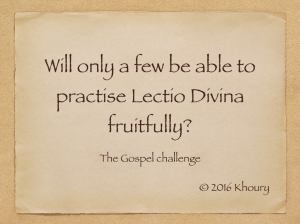
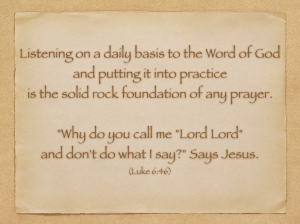



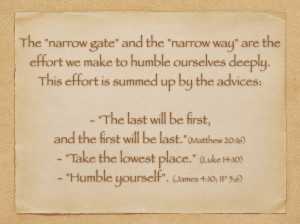

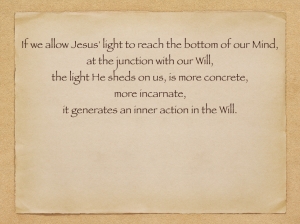
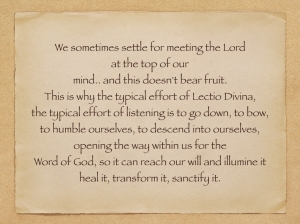
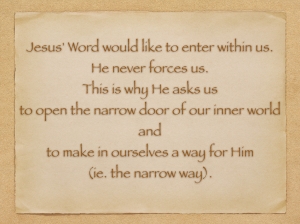

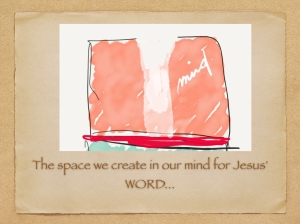
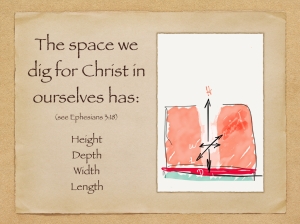
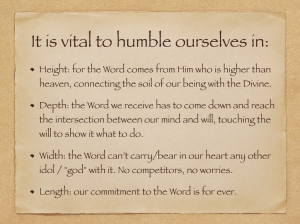
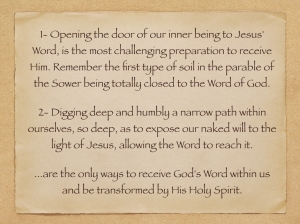
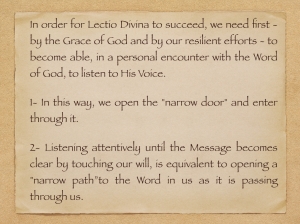
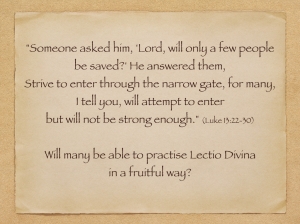
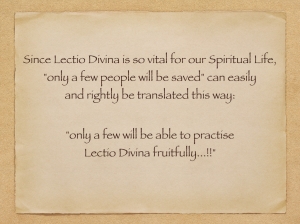
Labels:
General Help,
lectio divina,
listening,
Prayer of Recollection
 Jean is a French Catholic Theologian, specialised in Spiritual Formation, with more than twenty-five years of experience with Consecrated and Lay people. He obtained his Bachelors in Philosophy and his Masters in Spiritual Theology from Toulouse (France), and the Teresianum (Rome). He is presently completing his Ph.D. in Spiritual Theology at the Angelicum (Rome). Jean’s formation was greatly enhanced by the discalced Carmelite Fathers.
He has lectured in Spiritual Theology in different universities with a practical focus. Many articles, studies and books have been published internationally. In 2003, Jean founded the "School of Mary" which offers formation in Spiritual Life, many video courses being available at www.schoolofmary.org . Lectio Divina and Contemplative Prayer are amongst the most important forms of prayer addressed.
Jean gives Spiritual Direction on a regular basis and also gives retreats. He is married, has a daughter and is based in London.
Jean is a French Catholic Theologian, specialised in Spiritual Formation, with more than twenty-five years of experience with Consecrated and Lay people. He obtained his Bachelors in Philosophy and his Masters in Spiritual Theology from Toulouse (France), and the Teresianum (Rome). He is presently completing his Ph.D. in Spiritual Theology at the Angelicum (Rome). Jean’s formation was greatly enhanced by the discalced Carmelite Fathers.
He has lectured in Spiritual Theology in different universities with a practical focus. Many articles, studies and books have been published internationally. In 2003, Jean founded the "School of Mary" which offers formation in Spiritual Life, many video courses being available at www.schoolofmary.org . Lectio Divina and Contemplative Prayer are amongst the most important forms of prayer addressed.
Jean gives Spiritual Direction on a regular basis and also gives retreats. He is married, has a daughter and is based in London.
Tuesday, 25 October 2016
164: Lectio Divina, from the Human to the Divine Author
The
Sacramental Nature of the Proclamation of the Word of God
Listening
to the Word is epitomised in the word “Manducatio”
(Latin) or
"Manducation", which
is an obsolete word that means
"the taking of food", to consume the Word, chew, eat,
ruminate, digest, intake.
“Manducation”
is used in monastic theology,
and refers to the full operation of eating the Word of God, the
English equivalent being “ingestion”.
This
operation is a sacred operation for when Jesus wants to talk to us He
gives us a Word. His Words are Spirit and Life, Holy Spirit and
Divine Life. Receiving this Word is therefore a sacred operation. In
the most recent theological thought and in the Magisterium we
often find underlined the Sacramental dimension of the manducatio
of the Word of God.
Listening
to the Word of God at Mass - during the Liturgy of the Word and
thereafter through the Daily Readings – is, consequently, a
sacramental operation. In any sacrament, we have at least two
dimensions: the visible Sign used (ie. water, wine, oil,...) and the
invisible Grace. In the case of the ingestion of the Word of God
(liturgically) we also have two dimensions: 1- The letter or literal
meaning of the text, audibly proclaimed and 2- The invisible Word
that Jesus utters. The Risen Lord, present among us uses one of the
words of these texts, or an expression or a verse to talk to us, to
say something to us, to give us a Word. The operation is like the
Eucharist where the breaking of the Bread of His Word also takes
place.
In
this sacred operation and sacrament, the golden thread of the
Communication of the Grace of God is an intelligible one. The words
that are proclaimed are words that we are supposed to grasp with our
mind, and the Word that the Lord will pronounce, even if it is
sacred, will use our mind, lifting it up, and nourishing it with
God's Light and Love. Other Sacraments, the normal seven sacraments -
except Confession - have a more reduced use of the mind and a greater
use of the symbol (Water, Oil, Bread, Wine,...). These other
sacraments (except Confession) may talk essentially more to the
depths of our being (the spirit) which is a supra-conscious area
(above consciousness) rather than the conscious mind.
The
Sacramental Dimension of the Process of Listening to the Word of God
The
operation of the manducation of the word of God, having to
deal with the human mind throughout, faces various challenges and
temptations that can become obstacles. Why so? It is very important
to notice that in modern times the Church has to clearly define the
co-existence in the Bible of two authors: the Divine Author of the
entire Bible who inspired all the words and who inspired only the
words that God wanted the human authors to put down, and the said
human authors who used their individual styles, capacities, talents,
experience in order to write the sacred texts under the inspiration
of the Holy Spirit. The existence of the human authors and a correct
understanding of the Catholic Theory of Inspiration of the Bible led
the Church to impel exegetes to study the human authors, their
literary styles, intentions, tools,... in order to fully understand
the text.
The
science of exegesis was dedicated for more than 150 years to this
study. The analysis of the texts with all scientific tools available
to understand its letter or literal meaning was deployed with great
energy and enthusiasm. As a result many studies and monographic works
were written to explain each book of the Bible. All human industry
was involved in this endeavour. As a result, often the researcher and
writer as well as the reader have the impression of knowing the ins
and outs of each book. All this effort can only be praised. It is
needed and we can never afford to have the Bible in our hands without
using these results, particularly the soundest ones.
Now,
if we come back to the sacramental operation of the manducatio
of the the Word of God, we will find that two movements are needed:
1- explained in the one described above: understanding the text in
its context, understanding the intent of the Author, and the tools
and ways he used these in order to express it. 2- the need to lift up
the mind, to focus the mind (our inner ear) on the Divine Author, on
the Risen Lord who wants to talk to us.
The
first operation is realised through the natural light of reason and
at the most with the general help of the Grace of God, the general
Light of Faith.
The
second operation can only be achieved with the specific help of the
Grace of God, ie. the direct and personal intervention of the Holy
Spirit in us, facilitating the communication (or coming) of the Word
of Jesus in us.
The
pitfall that any believer can fall into is to reduce or transform the
operation of listening (manducatio) into the first operation:
understanding the text, and extracting from it all that a serious
intelligent study can offer. After completing this first action and
thinking that he knows by then the ins and outs of the text, he or
she will hit the "bottom" of the Word (see drawing)... will
block the Sacramental operation, will make the text opaque and not
transparent.
If
we were to use the image of stained glass, we can say that focusing
on the strictly literal meaning, thinking that we possess the ins and
outs of it, is like focusing only on the pigment of a pane of stained
glass. There is no vision of the essence of the stained glass, there
is no vision of the light that comes through it. The excessive focus
only on the stained glass itself, the closeness of our attention to
it, makes it paradoxically opaque. It ends up by blocking the Word
that comes from God through the literal meaning of the text.
The
study of the text in this way, the study of the human author instead
of remaining open to God, to the Divine Author, imprisons the human
understanding of it, enclosing the text in the human comprehension of
the mind. It puts the Divine Author into the shade and makes Him
vanish. The sacred operation of listening, ingesting the Word ,cannot
take place.
Thus
the act of faith in the Word is improperly done, it ends at the
bottom of the text instead of ending at Jesus' Mouth so to speak.
Catholic
Theory of Inspiration
Here
is the correct expression of the catholic theory of inspiration:
"For, by supernatural power, He so moved and impelled them to
write - He was so present to them - that the things which He ordered,
and those only, they, first, rightly understood [use
of the mind], then willed
faithfully [use of the will]
to write down, and finally expressed [art
of expressing] in apt words and with infallible truth.
Otherwise, it could not be said that He was the Author of the entire
Scripture." (Pope Leo XIII, "Providentissimus Deus",
20) It is because the Holy Spirit was capable of elevating their
minds and moving them, moving their will, helping them in the art of
choosing, that God is the Author.
If
we understand properly the catholic theory of inspiration, we will
understand how the Holy Spirit inspired the human authors, guided
their minds to choose the words He wanted, moved their wills to
choose them and help their judgement, to choose the words and only
those words that God wanted. Understanding properly how God is the
Real Main author of the Bible and in which exact sense the human
author is author, is to see the exact interaction between the Holy
Spirit and the different faculties of the human author, to adjust
thoroughly our act of faith in the Word of God that we read, and to
show us how it is as bottomless as stained glass is. It shows the
exact perspective from which the study of the human author must be
viewed as this will determine the contours of the Word of God, and
will avoid the “bottom” or basic meaning (see drawing below). In
sum, if we study the limits of each piece of the stained glass we are
in fact studying its human expression. But it is God from within, or
the light from behind, that illumines the Text, makes it alive, makes
it Sacramental, ie. under the Power of the Action of the Holy Spirit,
here and now, every time the Sacrament is given (every time the Word
is proclaimed and afterward “manducated” during Lectio
Divina).
Conclusion
When
practising Lectio Divina, we need first to understand the
text, and we cannot avoid this step. The material aspect of the Word,
the text, the material aspect of the Sacrament has to be laid down,
explained, understood.
As
a second stage, one has to allow a sacramental "distance"
with the Text in order to listen through/to, to read through it,
exactly as we would do with a beautiful pane of stained glass. After
having contemplated the beauty of the craftsmanship, we will need to
go back a few meters, lift our gaze to the entire stained glass
window and see through it the light, the reflections that it offers
to the Divine Light of the Risen Lord. Only under these conditions
can the Lord talk to us.
Our
Act of Faith in the Word we read could be weakened by attending at
length to the exegetical explanations offered by serious studies. We
could then have the impression of understanding the text, its ins and
outs, and end up by hitting an opaque wall (the bottom of the Sacred
Text) instead of renewing our Act of Faith in the Fact that these
Words are inspired by God and that therefore their limits are God's
limits, that their "bottom" so to speak is God himself,
Jesus himself who inspired them and who wants to talk to us.
We
are therefore invited to go from, first, a human understanding (at
most with the general help of the Light of Faith) to a divine
knowledge directly and personally given to us by the Holy Spirit,
here and now, that does not come to us aside from the letter of the
text, but through it, exactly as the Light does with the Stained
Glass. The correct sacramental balance here between the Letter and
the Spirit, between the limits that the letter offers (only a
contour) and the amazing new depths that God can offer to it here and
now, is achieved!
It
is never a choice between the Letter and the Spirit. It is a choice
not to remain imprisoned in the letter, but seeing that the letter
has an opening toward God, allowing the Risen Lord here and now to
talk to us.
It
is never a matter of twisting the letter to our liking. It is never
taking under our control the letter, trying to guess what the Lord
wants to say. It is about doing a vigorous act of Faith in God who
inspired this letter, and who is present here and now and capable to
make it alive today in a unique way, so it becomes real food for all
of our being and not a purely intellectual endeavour.
As
we can see, the correct understanding of the catholic theory/notion
of inspiration with its delicate divine vertical balance between the
Divine Author and the human author, offers the only way for a
Sacramental Manducation of the Word of God.
If
any of the authors is misunderstood, or if the relationship between
the two authors is misunderstood, our act of Faith during the
Proclamation of the Word and during the Lectio Divina Manducation
will be blocked and the Grace of God will not be "triggered"
and will definitely not come through.
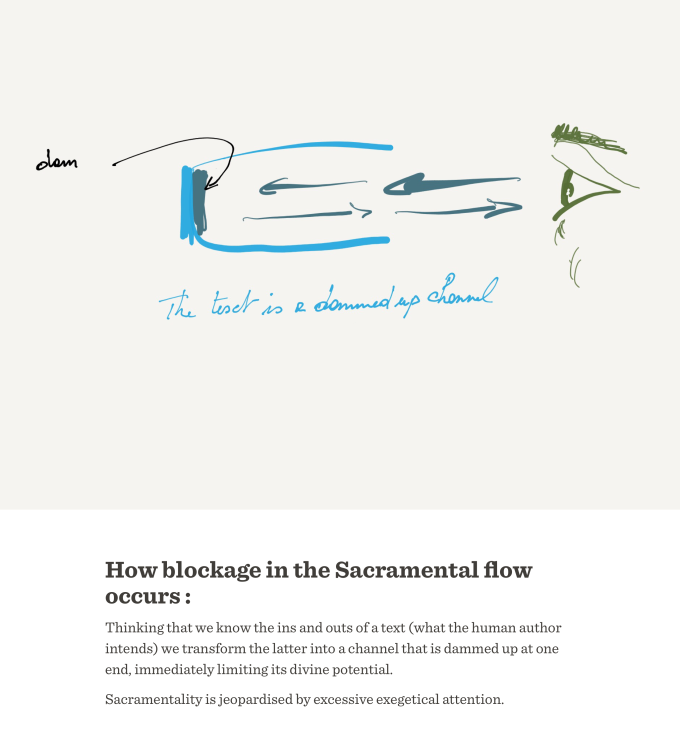
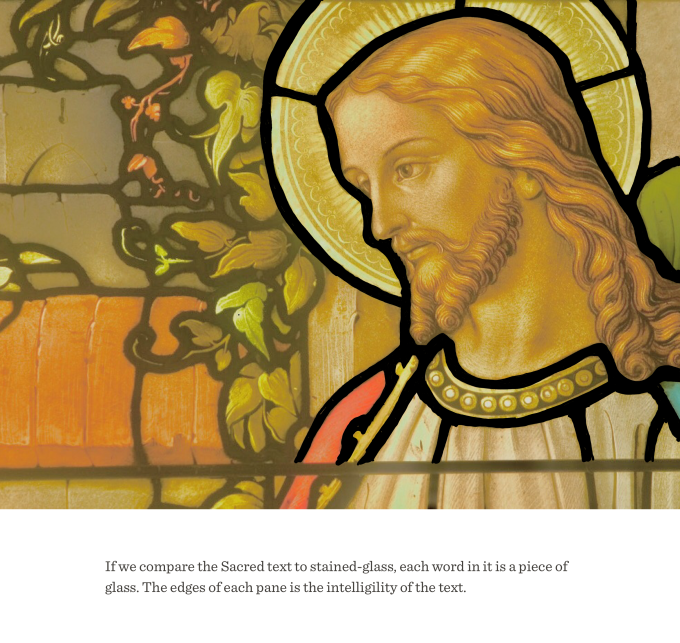
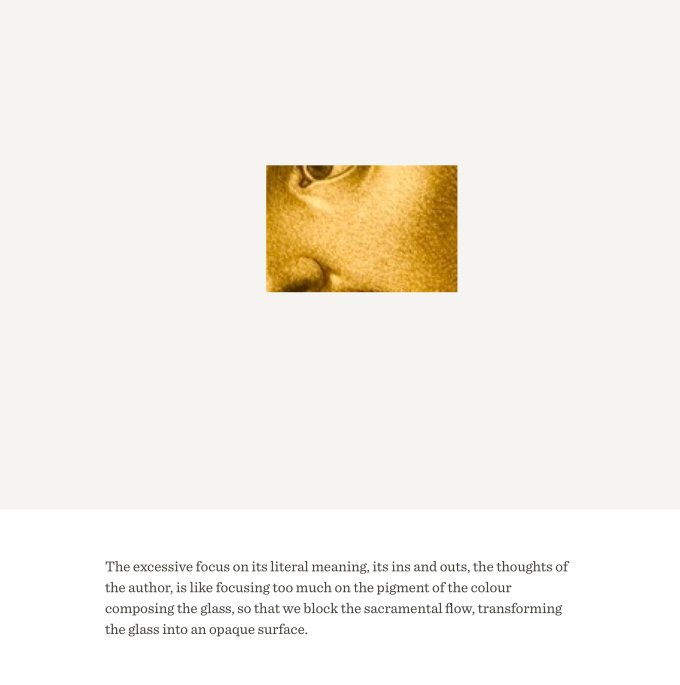
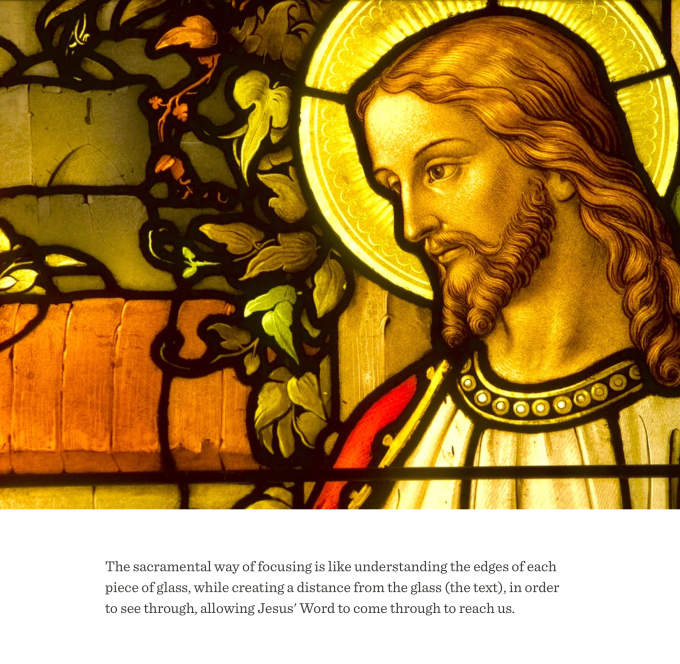
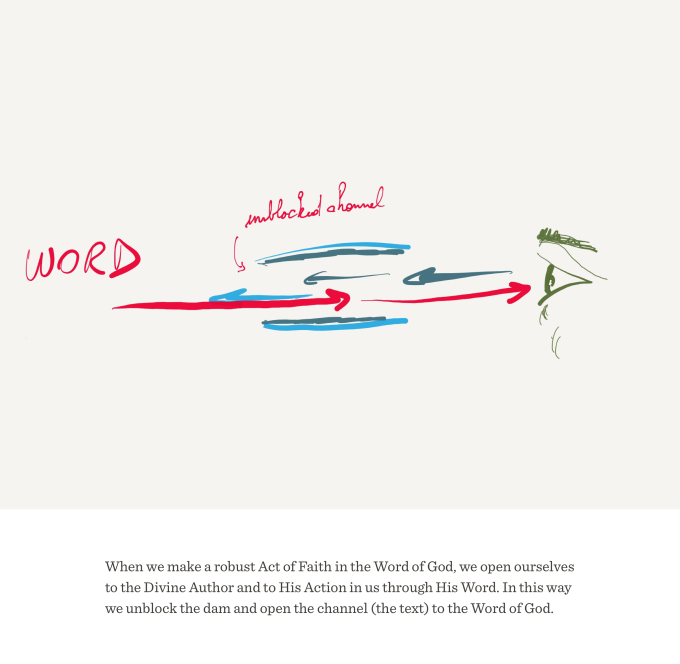
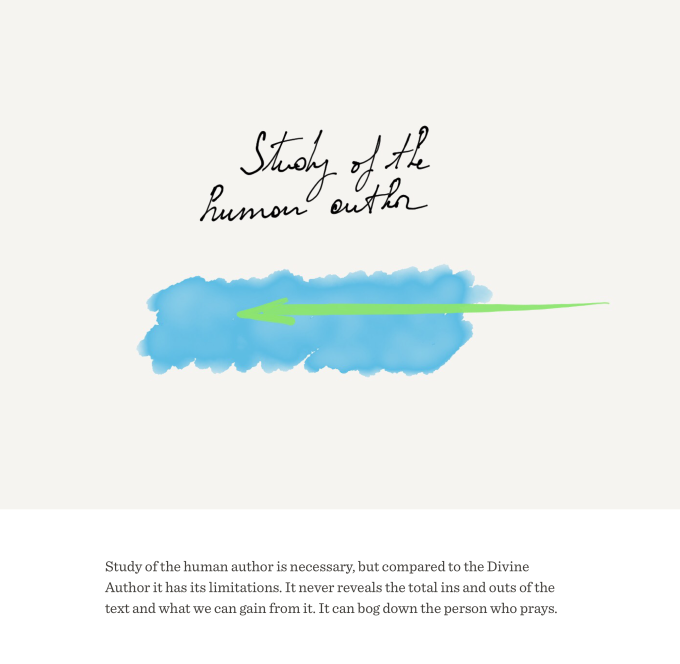
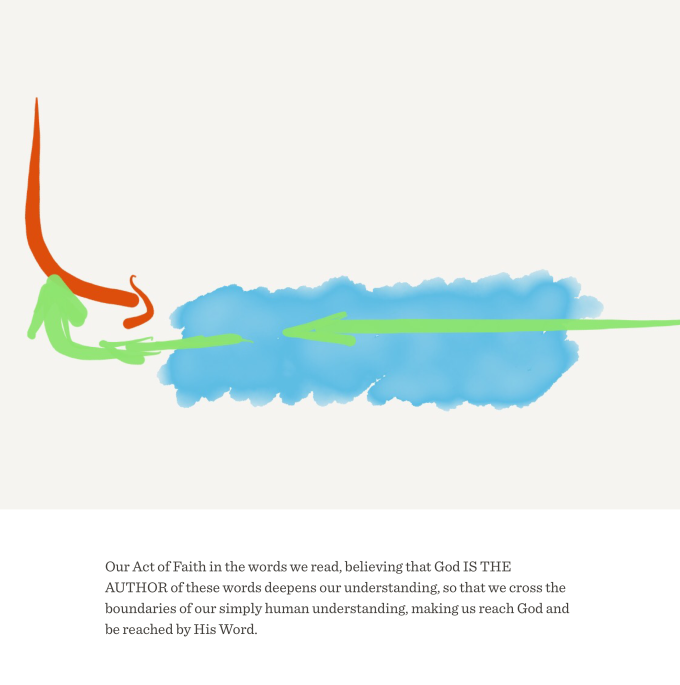
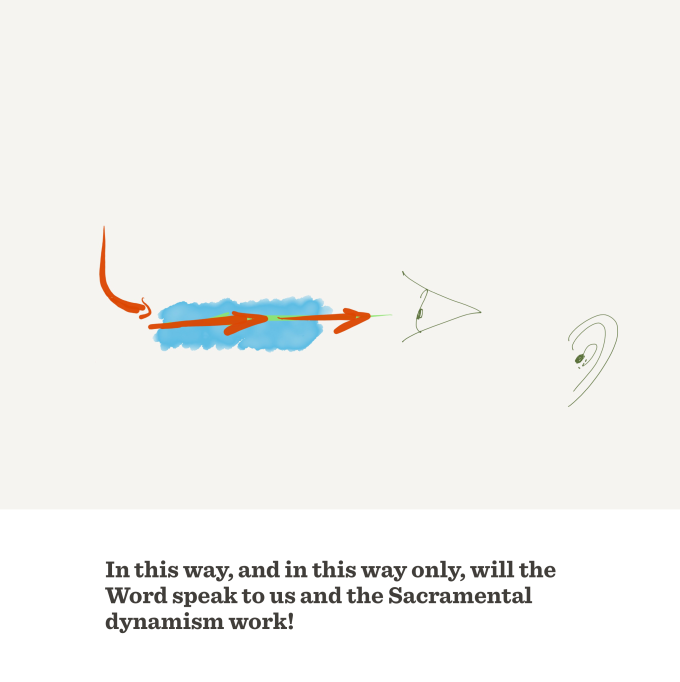
Labels:
lectio divina,
listening,
Sacrament,
Stained-glass,
Word of God
 Jean is a French Catholic Theologian, specialised in Spiritual Formation, with more than twenty-five years of experience with Consecrated and Lay people. He obtained his Bachelors in Philosophy and his Masters in Spiritual Theology from Toulouse (France), and the Teresianum (Rome). He is presently completing his Ph.D. in Spiritual Theology at the Angelicum (Rome). Jean’s formation was greatly enhanced by the discalced Carmelite Fathers.
He has lectured in Spiritual Theology in different universities with a practical focus. Many articles, studies and books have been published internationally. In 2003, Jean founded the "School of Mary" which offers formation in Spiritual Life, many video courses being available at www.schoolofmary.org . Lectio Divina and Contemplative Prayer are amongst the most important forms of prayer addressed.
Jean gives Spiritual Direction on a regular basis and also gives retreats. He is married, has a daughter and is based in London.
Jean is a French Catholic Theologian, specialised in Spiritual Formation, with more than twenty-five years of experience with Consecrated and Lay people. He obtained his Bachelors in Philosophy and his Masters in Spiritual Theology from Toulouse (France), and the Teresianum (Rome). He is presently completing his Ph.D. in Spiritual Theology at the Angelicum (Rome). Jean’s formation was greatly enhanced by the discalced Carmelite Fathers.
He has lectured in Spiritual Theology in different universities with a practical focus. Many articles, studies and books have been published internationally. In 2003, Jean founded the "School of Mary" which offers formation in Spiritual Life, many video courses being available at www.schoolofmary.org . Lectio Divina and Contemplative Prayer are amongst the most important forms of prayer addressed.
Jean gives Spiritual Direction on a regular basis and also gives retreats. He is married, has a daughter and is based in London.
Thursday, 20 October 2016
Homily on the Transfiguration of Christ (St. Cyril of Alexandria)
Copied:
By St. Cyril of Alexandria
(Commentary on Luke, Homily 51)
But I say unto you truly, there are some standing here who shall not taste of death, until they have seen the kingdom of God. After about eight days, He took Peter, and John, and James, and went up to the mountain to pray. And while He was praying, the look of His countenance was altered, and His raiment was white, shining like lightning. And behold! two men talked with Him, who were Moses and Elijah, who having appeared in glory, spoke of His death that He was about to accomplish at Jerusalem. Peter and they that were with him however were heavy with sleep, but having roused themselves, they saw His glory, and the two men that stood with Him. And it came to pass, that when they were separating from Him, Peter said unto Jesus, "Master, it is good for us to be here. Let us make three tabernacles, one for You, one for Moses and one for Elijah," not knowing what he was saying. While he spoke these things, there came a cloud, and overshadowed them; and they feared as they entered the cloud. And there was a voice from the cloud, saying, "This is My beloved Son, hear Him." And when there was the voice, Jesus was found alone; and they kept silence, and told no man in those days any of the things they had seen. (Luke 9:27-36)
Those who are skillful in the combat rejoice when the spectators clap their hands, and are roused to a glorious height of courage by the hope of the chaplets of victory. So those whoso desire it are to be counted worthy of the divine gifts, and who thirst to be made partakers of the hope prepared for the saints, who joyfully undergo combats for piety's sake towards Christ, and lead elect lives, not setting store by a thankless indolence, nor indulging in a mean timidity, but rather manfully resisting every temptation, and setting at nought the violence of persecutions, while they count it gain to suffer on His behalf. For they remember that the blessed Paul thus writes, "The sufferings of this present time are not worthy of the glory that is about to be revealed in us."
Observe, therefore, how perfectly beautiful is the method which our Lord Jesus Christ uses here also for the benefit and edification of the holy Apostles. For He had said unto them, "Whosoever will come after Me, let him deny himself and take up his cross every day, and follow Me. For he that will save his life shall lose it; and he that will lose his life for My sake shall find it." The commandment is indeed both for the salvation and honor of the saints, and the cause of the highest glory, and the means of perfect joy. For the choosing to suffer for the sake of Christ is not a thankless duty, but on the contrary makes us sharers in everlasting life, and the glory that is prepared. But as the disciples had not yet obtained power from on high, it probably occasionally happened, that they also fell into human weaknesses, and when thinking over with themselves any such saying as this, may have asked "how does a man deny himself?" or "how having lost himself does he find himself again?" And "what reward will compensate those who thus suffer?" Or "of what gifts will they be made partakers?" To rescue them therefore from such timid thoughts, and, so to speak, to mold them unto manliness, by begetting in them a desire of the glory about to be bestowed upon them, He says, "I say unto you, there are some of those standing here, who shall not taste of death until they have seen the kingdom of God." Does He mean that the measure of their lives will be so greatly prolonged as even to reach to that time when He will descend from heaven at the consummation of the world, to bestow upon the saints the kingdom prepared for them? Even this was possible for Him, for He is omnipotent, and there is nothing impossible or difficult to His all-powerful will. But by "the kingdom of God" He means the sight of the glory in which He will appear at His manifestation to the inhabitants of earth: for He will come in the glory of God the Father, and not in low estate like unto us.
How therefore did He make those who had received the promise spectators of a thing so wonderful? He goes up the mountain taking with Him three chosen disciples, and is transformed to so surpassing and godlike a brightness, that His garments even glittered with rays of fire, and seemed to flash like lightning. And besides, Moses and Elijah stood at Jesus' side, and spake with one another of His departure, which He was about, it says, to accomplish at Jerusalem: by which is meant the mystery of the dispensation in the flesh; and of His precious suffering upon the cross. For it is also true that the law of Moses, and the word of the holy prophets, foretold the mystery of Christ: the one by types and shadows, painting it, so to speak, as in a picture; while the rest in manifold ways declared beforehand, both that in due time He would appear in our likeness, and for the salvation and life of us all, consent to suffer death upon the tree. The standing, therefore, of Moses and Elijah before Him, and their talking with one another, was a sort of representation, excellently displaying our Lord Jesus Christ, as having the law and the prophets for His body guard, as being the Lord of the law and the prophets, and as foreshown in them by those things which in mutual agreement they before proclaimed. For the words of the prophets are not at variance with the teachings of the law. And this I imagine was what Moses the most priestly and Elijah the most distinguished of the prophets were talking of with one another.
But the blessed disciples sleep awhile, as Christ continued long in prayer - for He performed these human duties as belonging to the dispensation - and afterwards on awaking they became spectators of changes thus splendid and glorious. And the divine Peter, thinking perchance, that the time of the kingdom of God was even now come, proposes dwellings on the mountain, and says that it is fitting there should be three tabernacles, one for Christ, and the others for the other two, Moses and Elijah. "But he knew not," it says, "what he was saying." For it was not the time of the consummation of the world, nor for the saints to take possession of the hope promised to them; for as Paul says, "He will change our humble body into the likeness of His, that is, Christ's glorious body." As therefore the dispensation was still at its commencement, and not yet fulfilled, how would it have been fitting for Christ to have abandoned His love to the world, and have departed from His purpose of suffering in its behalf? For He redeemed all under heaven, by both undergoing death in the flesh, and by abolishing it by the resurrection from the dead. Peter therefore knew not what he said.
But besides the wonderful and ineffable sight of Christ's glory, something else was done, useful and necessary for the confirmation of their faith in Him: and not for the disciples only, but even for us too. For a voice was given forth from the cloud above, as from God the Father, saying: "This is My beloved Son, hear Him. And when there was the voice," it says, "Jesus was found alone." What then will he who is disputatious and disobedient, and whose heart is incurable, say to these things? Lo! Moses is there, and does the Father command the holy apostles to hear him? Had it been His will that they should follow the commandments of Moses, He would have said, I suppose, "Obey Moses; keep the law." But this was not what God the Father here said, but in the presence of Moses and the prophets, He commands them rather to hear Him. And that the truth might not be subverted by any, affirming that the Father rather bade them hear Moses, and not Christ the Savior of us all, the Evangelist has clearly marked it, saying, "When there was the voice, Jesus was found alone." When therefore God the Father, from the cloud overhead, commanded the holy apostles, saying, "Hear Him," Moses was far away, and Elijah too was no longer nigh; but Christ was there alone. Him therefore He commanded them to obey.
For He also is the end of the law and the prophets, for which reason He cried aloud to the multitudes of the Jews: "If ye had believed Moses, ye would have believed Me also, for he wrote of Me." But as they persevered even unto the end in despising the commandment given by the most wise Moses, and in rejecting the word of the holy prophets, they have justly been alienated and expelled from those blessings that were promised to their fathers. For "obedience is better than sacrifices, and to hearken than the fat of rams," as the Scripture saith. And thus much then of the Jews, but upon us who have acknowledged the revelation, all these blessings have necessarily been bestowed, by means of and as the gift of the same Christ, by Whom and with Whom, to God the Father be praise and dominion, with the Holy Spirit, forever and ever. Amen.
Labels:
Cyril of Alexandria,
Transfiguration
 Jean is a French Catholic Theologian, specialised in Spiritual Formation, with more than twenty-five years of experience with Consecrated and Lay people. He obtained his Bachelors in Philosophy and his Masters in Spiritual Theology from Toulouse (France), and the Teresianum (Rome). He is presently completing his Ph.D. in Spiritual Theology at the Angelicum (Rome). Jean’s formation was greatly enhanced by the discalced Carmelite Fathers.
He has lectured in Spiritual Theology in different universities with a practical focus. Many articles, studies and books have been published internationally. In 2003, Jean founded the "School of Mary" which offers formation in Spiritual Life, many video courses being available at www.schoolofmary.org . Lectio Divina and Contemplative Prayer are amongst the most important forms of prayer addressed.
Jean gives Spiritual Direction on a regular basis and also gives retreats. He is married, has a daughter and is based in London.
Jean is a French Catholic Theologian, specialised in Spiritual Formation, with more than twenty-five years of experience with Consecrated and Lay people. He obtained his Bachelors in Philosophy and his Masters in Spiritual Theology from Toulouse (France), and the Teresianum (Rome). He is presently completing his Ph.D. in Spiritual Theology at the Angelicum (Rome). Jean’s formation was greatly enhanced by the discalced Carmelite Fathers.
He has lectured in Spiritual Theology in different universities with a practical focus. Many articles, studies and books have been published internationally. In 2003, Jean founded the "School of Mary" which offers formation in Spiritual Life, many video courses being available at www.schoolofmary.org . Lectio Divina and Contemplative Prayer are amongst the most important forms of prayer addressed.
Jean gives Spiritual Direction on a regular basis and also gives retreats. He is married, has a daughter and is based in London.
Monday, 10 October 2016
A Day with St Elisabeth of the Trinity on the occasion of her Canonisation
On Saturday 15th October, we are happy to present a one day course on Elisabeth of the Trinity. She was a French Carmelite nun whose messages on the Interior Life would be of great value to us all. She will be canonised on Sunday 16th October and we invite you to attend the course to learn about the life and message of this courageous nun.
A day with Elisabeth of the Trinity
Saturday 15th October 2016
What content is covered?
The lectures during this day with her will focus on four key areas:
1. Knowing her life
2. An introduction to her writings
3. An introduction to her doctrine
4. Discovering and praying her "Prayer to the Trinity"
Dates and times of the Course are:
15th October 2016, from 10 am to 4:30 pm.
Refreshments are provided. Please bring a packed lunch.
Where does the course take place?
The course will take place at St Mary of the Angels, Moorhouse Road, Bayswater, London, W2 5DJ. ('Notting Hill Gate' or 'Bayswater' Tube Stations and Buses 7, 23, 27, 28, 31, 70, 328)
Who will teach the course?
The course will be taught by Jean Khoury, a full-time theologian who has studied and taught Spiritual Life in the Church for over twenty years. As well as lecturing world-wide on spiritual life and meditation, Jean is the author of several books, articles and studies on spiritual life and the founder of the School of Mary, a three-level formation in spiritual life (www.amorvincit.com).
Jean obtained a degree in Philosophy from the Institut Catholique de Toulouse (France), a Licence in Theology from the Teresianum (Rome) and a Masters in Spiritual Theology from the Institute Catholique de Toulouse (France). He is currently completing his PhD in Spiritual Theology at the Angelicum (Rome) with Monsignor François-Marie Léthel. Courses at the School of Mary constitute his sole source of income.
How much will the course cost?
The cost for the course is £25 for the day.
* Email schoolofmarylondon@gmail.com with your name and contact details and we will be in touch with details of how to pay the fee by bank transfer.
Who is Elisabeth of the Trinity?
Elisabeth of the Trinity is a French Carmelite nun. She was born is 1880 at Bourges, France, entered at the age of 21 at the Carmelite Monastery of Dijon, and lived only 5 years and died at the age of 26 on the 9th of November 1906.
She is much less known than her other French sister, St Therese of the Child Jesus, but deserves to be known as well for her life and message to the world. She is more discreet and her message is mainly on interiority. Her doctrine is so rich and deserves to be discovered.
She said: "I think that in Heaven my mission will be to draw souls by helping them to go out of themselves in order to cling to God by a wholly simple and loving movement, and to keep them in this great silence within which will allow God to communicate Himself to them and to transform them into Himself".
 Jean is a French Catholic Theologian, specialised in Spiritual Formation, with more than twenty-five years of experience with Consecrated and Lay people. He obtained his Bachelors in Philosophy and his Masters in Spiritual Theology from Toulouse (France), and the Teresianum (Rome). He is presently completing his Ph.D. in Spiritual Theology at the Angelicum (Rome). Jean’s formation was greatly enhanced by the discalced Carmelite Fathers.
He has lectured in Spiritual Theology in different universities with a practical focus. Many articles, studies and books have been published internationally. In 2003, Jean founded the "School of Mary" which offers formation in Spiritual Life, many video courses being available at www.schoolofmary.org . Lectio Divina and Contemplative Prayer are amongst the most important forms of prayer addressed.
Jean gives Spiritual Direction on a regular basis and also gives retreats. He is married, has a daughter and is based in London.
Jean is a French Catholic Theologian, specialised in Spiritual Formation, with more than twenty-five years of experience with Consecrated and Lay people. He obtained his Bachelors in Philosophy and his Masters in Spiritual Theology from Toulouse (France), and the Teresianum (Rome). He is presently completing his Ph.D. in Spiritual Theology at the Angelicum (Rome). Jean’s formation was greatly enhanced by the discalced Carmelite Fathers.
He has lectured in Spiritual Theology in different universities with a practical focus. Many articles, studies and books have been published internationally. In 2003, Jean founded the "School of Mary" which offers formation in Spiritual Life, many video courses being available at www.schoolofmary.org . Lectio Divina and Contemplative Prayer are amongst the most important forms of prayer addressed.
Jean gives Spiritual Direction on a regular basis and also gives retreats. He is married, has a daughter and is based in London.
Subscribe to:
Posts (Atom)







